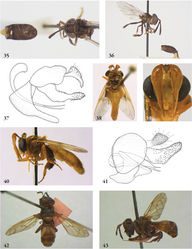Bardistopus
| Notice: | This page is derived from the original publication listed below, whose author(s) should always be credited. Further contributors may edit and improve the content of this page and, consequently, need to be credited as well (see page history). Any assessment of factual correctness requires a careful review of the original article as well as of subsequent contributions.
If you are uncertain whether your planned contribution is correct or not, we suggest that you use the associated discussion page instead of editing the page directly. This page should be cited as follows (rationale):
Citation formats to copy and paste
BibTeX: @article{Reemer2013ZooKeys288, RIS/ Endnote: TY - JOUR Wikipedia/ Citizendium: <ref name="Reemer2013ZooKeys288">{{Citation See also the citation download page at the journal. |
Ordo: Diptera
Familia: Syrphidae
Name
Bardistopus Mann – Wikispecies link – Pensoft Profile
- Bardistopus Mann, 1920: 61. Type species: Bardistopus papuanum Mann, 1920: 61, by original designation.
Description
Body length: 6–7 mm. Small, dark flies with very long antennae and oval abdomen, which in lateral view appears constricted. Head slightly wider than thorax. Face evenly convex. Lateral oral margins not produced. Vertex flat. Occiput ventrally narrow; dorsally slightly widened. Eye bare. Eyes in male not converging at level of frons; mutual distance much larger than width of antennal fossa. Antennal fossa about as high as wide. Antenna longer than distance between antennal fossa and anterior oral margin. Basoflagellomere about six times as long as scape. Postpronotum bare. Scutellum semicircular; without calcars. Anepisternum without sulcus; pilose anteriorly and posteriorly, widely bare in between. Anepimeron pilose on dorsal half, bare on ventral half. Katepimeron flat; pilose. Wing: vein R4+5 with posterior appendix; vein M1 perpendicular to vein R4+5 and vein M; crossvein r-m located around basal 1/7 of cell dm. Abdomen oval in dorsal view, but in lateral view appearing constricted due to flattened segment 2. Tergites 3 and 4 fused. Male genitalia: phallus furcate, with furcation point in apical half, strongly bent dorsad; epandrium without ventrolateral ridge; surstylus elongate, bent dorsad.
Diagnosis
Vein R4+5 with posterior appendix. Postpronotum bare. Abdomen in dorsal view oval; in lateral view constricted at segment 2. Basoflagellomere about six times as long as scape.
Discussion
No statements about taxonomic affinities of Bardistopus have been made previously, except Cheng and Thompson (2008)[1] who wrote that the name was ‘established for a Microdon species, which has a greatly elongate basoflagellomere’. Clearly the taxon does not belong to Microdon, because of the long basoflagellomere and the structure of the male genitalia (apically furcate phallus). These characters, combined with the bare postpronotum, suggest it might be related to Paramixogaster. However, the phylogenetic analysis of morphological characters by Reemer and Ståhls (in press)[2] place it as a sister group of a clade containing taxa of which the male has a furcate basoflagellomere: Schizoceratomyia, Furcantenna and Carreramyia. Future studies employing molecular data could help elucidate the phylogenetic affinities of Bardistopus.
According to Mann (1920)[3] the type specimens of the type species are females, but actually both are males (coll. USNM).
Diversity and distribution
Described species: 1. Solomon Islands: Ugi.
Taxon Treatment
- Reemer, M; Ståhls, G; 2013: Generic revision and species classification of the Microdontinae (Diptera, Syrphidae) ZooKeys, 288: 1-213. doi
Other References
- ↑ Cheng X, Thompson F (2008) A generic conspectus of the Microdontinae (Diptera: Syrphidae) with the description of two new genera from Africa and China. Zootaxa 1879: 21-48.
- ↑ Reemer M, Ståhls G (in press) Phylogenetic relationships of Microdontinae (Diptera: Syrphidae) based on parsimony analyses of combined molecular and morphological characters. Systematic Entomology 38.
- ↑ Mann W (1920) Ant guests from Fiji and the British Solomon Islands. Annals of the Entomological Society of America 13: 60-69.
Images
|
